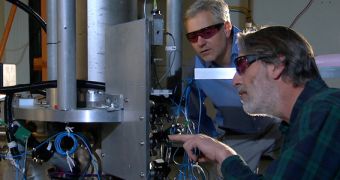Scientists with the US Department of Commerce's (DOC) National Institute of Standards and Technology (NIST) say that work on their latest atomic clock – which has been under construction for about a decade – has finally ended. The device, now called NIST-F2, has recently been evaluated as the world's most accurate time standard by the International Bureau of Weights and Measures (BIPM).
The BIPM, near Paris, in France, is responsible for integrating data from multiple atomic clocks around the world (including NIST's previous time standard-keeping instrument, the NIST-F1) into the Coordinated Universal Time (UTC) standard. Of all clocks involved in this collaboration, the new NIST-F2 is the most sensitive and accurate, the international agency said recently.
The atomic clock will from now on be used to complement the existing NIST-F1 instrument for keeping the civilian time and frequency standard in the United States. Its predecessor has kept the time in North America since 1999, and is extremely accurate in its own right. However, NIST-F2 is much more accurate, since it will not lose or gain a second in more than 300 million years.
By comparison, NIST-F1 has a level of accuracy of one second per 100 million years, which means that the new device is around 300 percent more efficient in keeping time. In both designs, the exact length of a second is determined by a cesium atom fountain. Before releasing the first official performance data to the public, the Institute sent the information to the BIPM for analysis.
NIST has been striving to advance atomic timekeeping since it first entered the atomic clock manufacturing business, in the 1950s. Over time, precise time-keeping has become part of the basic infrastructure of modern society, finding uses in important assets such as the US Global Positioning System (GPS) satellite network.
Meanwhile, this technology has made its way into power-grid control systems and cellular telephone, to mention a few applications. Accurate time-keeping has traditionally led to innovation and technology improvements on a scale that even atomic clock developers could not predict.
“If we've learned anything in the last 60 years of building atomic clocks, we've learned that every time we build a better clock, somebody comes up with a use for it that you couldn't have foreseen,” argues the lead designer of the NIST-F2, NIST physicist Steven Jefferts. He says that continuous comparisons between F1 and F2 will allow his team to further improve its designing skills.
Jefferts reveals that both atomic clocks define as a second as the time it takes for a particular type of cesium atom to complete 9,192,631,770 vibrations. The main difference between the two is that F1 operates at 27 degrees Celsius (80ºF, or room temperature), whereas F2 operates at cryogenic temperatures of -193ºC (-316ºF), roughly the average temperature on Saturn's largest moon, Titan.

 14 DAY TRIAL //
14 DAY TRIAL //